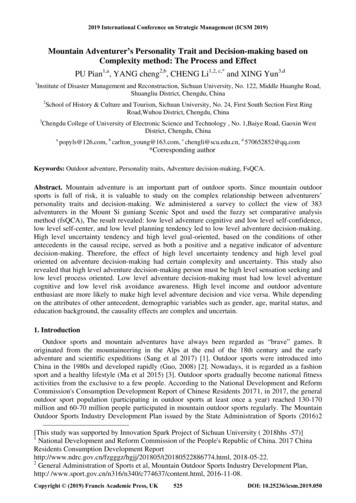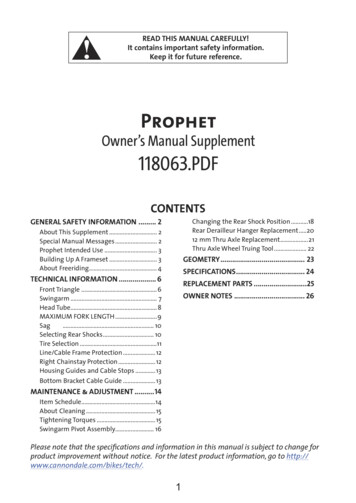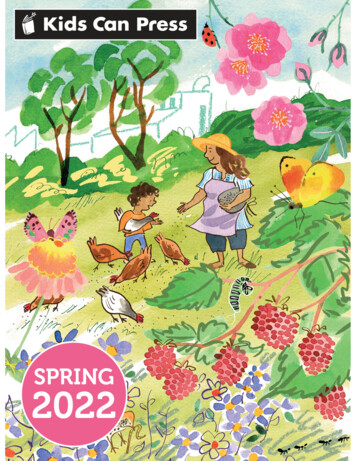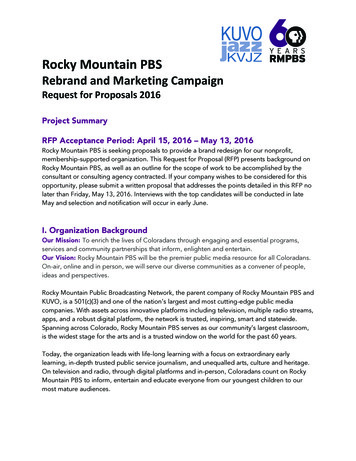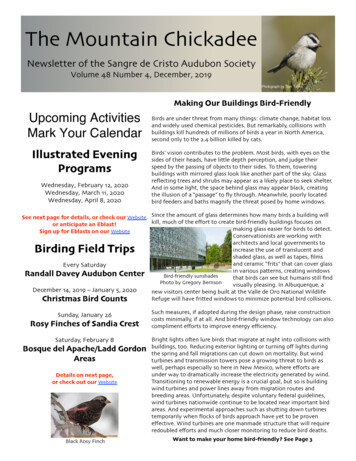
Transcription
The Mountain ChickadeeNewsletter of the Sangre de Cristo Audubon SocietyVolume 48 Number 4, December, 2019Photograph by Tom TaylorMaking Our Buildings Bird-FriendlyUpcoming ActivitiesMark Your CalendarIllustrated EveningProgramsWednesday, February 12, 2020Wednesday, March 11, 2020Wednesday, April 8, 2020Birds are under threat from many things: climate change, habitat lossand widely used chemical pesticides. But remarkably, collisions withbuildings kill hundreds of millions of birds a year in North America,second only to the 2.4 billion killed by cats.Birds’ vision contributes to the problem. Most birds, with eyes on thesides of their heads, have little depth perception, and judge theirspeed by the passing of objects to their sides. To them, toweringbuildings with mirrored glass look like another part of the sky. Glassreflecting trees and shrubs may appear as a likely place to seek shelter.And in some light, the space behind glass may appear black, creatingthe illusion of a “passage” to fly through. Meanwhile, poorly locatedbird feeders and baths magnify the threat posed by home windows.See next page for details, or check our Website, Since the amount of glass determines how many birds a building willkill, much of the effort to create bird-friendly buildings focuses onor anticipate an Eblast!making glass easier for birds to detect.Sign up for Eblasts on our WebsiteConservationists are working witharchitects and local governments toincrease the use of translucent andshaded glass, as well as tapes, filmsand ceramic “frits” that can cover glassEvery Saturdayin various patterns, creating windowsRandall Davey Audubon CenterBird-friendly sunshadesthat birds can see but humans still findPhoto by Gregory Bernsonvisually pleasing. In Albuquerque, aDecember 14, 2019 – January 5, 2020new visitors center being built at the Valle de Oro National WildlifeRefuge will have fritted windows to minimize potential bird collisions.Christmas Bird CountsBirding Field TripsSunday, January 26Rosy Finches of Sandia CrestSaturday, February 8Bosque del Apache/Ladd GordonAreasDetails on next page,or check out our WebsiteBlack Rosy FinchSuch measures, if adopted during the design phase, raise constructioncosts minimally, if at all. And bird-friendly window technology can alsocompliment efforts to improve energy efficiency.Bright lights o.en lure birds that migrate at night into collisions withbuildings, too. Reducing exterior lighting or turning off lights duringthe spring and fall migrations can cut down on mortality. But windturbines and transmission towers pose a growing threat to birds aswell, perhaps especially so here in New Mexico, where efforts areunder way to dramatically increase the electricity generated by wind.Transitioning to renewable energy is a crucial goal, but so is buildingwind turbines and power lines away from migration routes andbreeding areas. Unfortunately, despite voluntary federal guidelines,wind turbines nationwide continue to be located near important birdareas. And experimental approaches such as shutting down turbinestemporarily when flocks of birds approach have yet to be proveneffective. Wind turbines are one manmade structure that will requireredoubled efforts and much closer monitoring to reduce bird deaths.Want to make your home bird-friendly? See Page 3
Audubon ActivitiesIllustrated Evening ProgramsWednesday February 12, 2020A Birding Photo Journey: Personal Highlights from Across the Country, Tom TaylorJoin chapter board member Tom Taylor as he takes a birding photo-tour across the country, starting with the seasonalbehavior of birds in New Mexico and Arizona before capturing spring songbirds of the Texas coast and upper Midwest.Wednesday, March 11, 2020River of Birds - Vera Cruz, Mexico, Robert TempletonSince 2006 Robert Templeton has worked as a writer and educator at the Veracruz River of Raptors, a coastal count sitein central Mexico that records 4.5 million raptors each fall. Through video, photos and maps, he will present timing andpopulation data from the count, and explore questions such as how climate change is affecting the migration.Wednesday, April 8, 2020Birds of the Chiricahua Mountains, Renata GoldenRenata Golden will talk about the birds of southeastern Arizona’s Chiricahua Mountains, and the best places to see them.In addition to Cave Creek Canyon, learn about lesser-known spots such as Horseshoe, Sulphur and Whitetail Canyons. Shewill also share information on the results of Christmas Bird Counts in the Chiricahuas over the last 20 years.Evening programs will be held at 6:30 on the second Wednesday of February, March and April. These free illustrated talks on birdconservation and other topics concerning the natural world are held in the new Henderson Pavilion at the Randall Davey AudubonCenter and Sanctuary, at the end of Upper Canyon Road in Santa Fe. Abundant parking is available; bring a flashlight. Everyone iswelcome and the building is wheelchair accessible. A brief update of environmental issues and chapter activities precedes the program.Field TripsEvery SaturdayRandall Davey Audubon CenterEvery Saturday, a naturalist will lead awalk around the RDAC grounds, anAudubon Important Bird Area, at 8:30AM. Binoculars can be provided. Dressappropriately. All welcome. Forinformation, call: 983-4609.December 14, 2019 - January 5, 2020Christmas Bird CountsThe National Audubon Society began theChristmas Bird Counts (CBC) in 1901.These counts provide importantinformation about wintering birdpopulations. There are close to 30 countsheld in the state of New Mexico and theSangre de Cristo Chapter participates in10 counts in its area. The CBCs will beheld between mid-December and midJanuary. Novices are welcome and will bepaired with more experienced birders. Forinformation on Christmas Bird Countsaround New Mexico, including the SantaFe area, click here: NMChristmasCountsContact the leaders of each count youwant to participate in to makearrangements.Santa Fe Place Mall outside of theHobby Lobby at 8:30 AM. Let theleader know if you plan to comeso that notice of any changes inthe trip plans can becommunicated.Sunday, January 26Saturday, February 8Rosy Finches atSandia CrestBosque del Apache/Ladd Gordon AreasLeader: Tom Jervis505-988-1708Jervidae@cybermesa.comLeader: Linda Mowbray,A fun trip to Sandia Crest to see RosyFinches and other winter montanespecies, and watch the bandingoperation. We’ll spend the morninginside the Crest House and if theweather is cooperative, take a walkthrough the snowy woods to see whatmay be around. We will carpool fromSanta Fe. Meet on the west side of theOn this long one-day trip weshould see large numbers of SnowGeese and Sandhill Cranes, plusraptors and other waterfowl.Appropriate for all levels ofbirders. Spotting scopes are useful.Contact leader for meeting timeand place.505-989-8295birdinglinda@yahoo.comSangre de Cristo Audubon Society Field Trips are designed to promote understanding and appreciation of wildlife and their habitats. Our aim is to cultivate awareness ofoutdoor ethics in an atmosphere of friendly companionship. Field trips are free and open to the public. Some area entry fees are required and driving costs are shared.Participants are expected to carpool whenever possible. On all field trips, wear walking shoes and clothing appropriate for the weather. Bring water, lunch, and binoculars. Nopets, please. Always call the trip leader before the trip. Trips may be cancelled for a variety of reasons.2
Audubon New MexicoHow to Make Your House Bird-FriendlyRandall Davey Audubon Centerand SanctuaryBy Bruce Dale, Central New Mexico Audubon SocietyUp to a billion birds are killed annually in windowcollisions across North America. Small buildings, such asThe grounds at the Randall Davey Audubon Center are openMonday to Saturday, 8:00 AM to 4:00 PM, closed Sundays homes, are a leading danger, especially for migratorysongbirds. Fortunately, there are things you can do as a(and in January). Stroll thehomeowner to make your windows bird-safe. First, checkgardens as birds visit thethe location of your bird feeder. Feeders (and bird baths)birdfeeders, or walk theshould be positioned as close to a window as possible trails and enjoy the naturalbeauty and serenity of thewithin 18 inches. This creates a safe landing target, as well135-acre wildlife sanctuary.as a safe launch pad for the birds. You can even buyAdditionally, the Daveyfeeders that will stick to the window with suction cups.Center is an environmentaleducation center and offersAnother option is to put up a window screen. If thea variety of educationalwindow came with a screen that fits on the exterior of theevents. Please check theirglass, install it. But a screen can be anything that createswebsite for details. Theinterference with theCenter is located at the endreflections on the glass. Aof Upper Canyon Road onsimple curtain made withthe far east side of Santa Fe.twine and pine conessuspended in front of theHistoric House Tourswindow works well and has anatural look. Ribbons orStep back in time as you stroll through the old Santa Festyle home (originally a lumber mill built in 1847 by the U.S. string with ornamentalArmy) of the artist Randall Davey (1887-1964). This docent- doodads attached has adecorative flair. Variousled tour will give you an opportunity to view some ofReady-to-hang curtain of fineDavey’s most spectacular works of art, as well as a beautiful screen products can benylon monofilament linescollection of Spanish Colonial and European antiques. Tours purchased online atbirdscreen.com. Visual markers placed directly on theare held each Friday at 2:00 PM. Reservations areglass also will work if they are closely spaced.recommended. Cost is 5 per person. For information callUnfortunately, most decals505-983-4609. Click here for registration and more details.sold in nature shops are noteffective and interfere tooSangre de Cristo Chapter Will Sponsormuch with your view. Butthere are products testedScience Classes for Grade Schoolersand approved by theAmerican Bird ConservancyThe Board of the Sangre de Cristo Chapter of the Audubonthat most people will findSociety has agreed to sponsor Audubon NM's outdoorquite acceptable. ABCscience curriculum for students in three separate classes atBirdTape and FeatherCesar Chavez Elementary School in Santa Fe. The programFriendly dots are affordablewill involve both classroom and field sessions - includingBird-friendly adhesive dots on theand very effective. Thesetwo trips per year for each class to the Randall Daveyexterior of a windowAudubon Center - and will expose approximately 75 studentsand other approved itemsin third, fourth and fi.h grades to the nature-orientedare listed at birdsmartglass.org and can be ordered online.science curriculum. Although Sangre de Cristo AudubonSociety’s funds are limited, the Board hopes to be able toAnd if you have kids, let them decorate a window withexpand the program in the future.stripes and squiggles using tempera paint. It’s nontoxicand can easily be removed a.er migration season. Bymaking your windows bird-safe, you can have confidenceLike Birds? Join Audubon!that the migratory birds that stop over in your yard inspring and fall will return next season.Sangre de Cristo Chapter: https://audubonsantafe.org/Audubon New Mexico: https://nm.audubon.org/3
Environment Newsfor at least 310 North American bird species. But directconsumption aside, insects are also critically importantto birds in other ways. More than 85 percent offlowering plants require animal pollination; in mostcases this job is done by insects. Many birds, forexample, eat small fruits or seeds, and a lot of these arefrom insect-pollinated plants.Where Our Hummingbirds GoAlthough hummingbirds occupy almost all of NorthAmerica during summer months, these tiny birds remaintropical at heart and most do migrate. The majority flyto Mexico or Central America for the winter, makingimpressively long journeys, especially considering thediminutive size of these birds.Many scientists believe agricultural alchemy plays a bigrole in insect declines. Today, the world's most widelyused agricultural pesticides are neonicotinoids,neurotoxins absorbed and stored in plant tissues so theyrepel insect pests. Neonics, as they are also known, arenow banned in theEuropean Union becauseof their impact onhoneybees. A number ofU.S. states have alsointroduced legislationattempting to prohibit orlimit their use, althoughmost corn-growingacreage in the UnitedStates is still treated with neonics. Persistent and watersoluble, the compounds are highly toxic to a broadrange of insects and other invertebrates. And they reachwell beyond farm fields, leaching into watersheds, risingup in dust and soaking into soil adjacent to farms,toxifying insect food plants there. Although theseinsecticides are considered less dangerous to manyvertebrates than are other pesticides, an ABC study in2013 determined that a single neonic-coated seed cankill a bird the size of a Blue Jay.Like other birds, hummingbirds migrate south in searchof flowers, insects and other food sources. Many makethis journey during the late summer and fall, spurrednot by hunger or falling temperatures but by decreasingdaylight hours. In late winter and early spring, theyreturn north to breeding grounds in the United Statesand Canada, where summer food supplies are abundant.For its size, the three-inch-long Rufous Hummingbird,familiar to many birders in the Santa Fe area, makes oneof the longest migratory trips in the bird world. Its3,900-mile journey is roughly equal to 78.4 million bodylengths. (The Arctic Tern's one-way journey of 11,000miles, by comparison, is less than 52 million bodylengths.) The Rufous Hummingbird's migration routeforms a clockwise loop: The birds leave their Mexicanwintering grounds in early spring, following the PacificCoast to Washington State and Canada by May. A.er ashort sojourn in the North, they travel south throughthe Rocky Mountains; many pass through New Mexico.Rufous Hummingbird populations are on the declinedue to habitat loss.Another local visitor, the Black-chinned Hummingbird,occupies a large portion of the western United Statesduring the summer. This is one of the most adaptablehummers found in our country, occupying a wide rangeof habitats, including urban areas. A.er breeding, manyadult birds will move toward higher elevations to feaston mountain flowers before heading south in the fall.Most travel to western Mexico, although someoverwinter along the Gulf Coast. Populations of Blackchinned Hummingbirds are on the rise, likely due to thepopularity of backyard hummingbird feeders and thisbird's tolerance for varied habitats.American Bird ConservancyProving a direct link between bird declines andpesticides' impact on their insect food is difficult givenother factors also at play, including habitat loss, climatechange and the direct physical effects of the chemicalson birds. But a study published in the journal Nature in2014 was the first to “provide direct evidence that thewidespread depletion of insect populations byneonicotinoids has knock-on effects on vertebrates.”That study, in the Netherlands, found that rapiddeclines in Eurasian Skylarks, Barn Swallows, WesternYellow Wagtails and other insect-eating farmland birdswere likely “the result of a depletion of the birds' food— insects.”Are Birds Running Out of Food?From farm fields to alder plantations to remainingrainforest, conservationists now ponder, with a sense ofurgency, humans’ unintended and intentional impactson insects and birds. Exactly what insect declines meanfor birds, and for us, is an emerging picture, but manyspecies seem to be telling us something we may havetaken for granted before: There can't be birds withoutbugs.American Bird ConservancyAlthough there are not many long-term studies oninsects in North America, the studies done haverevealed sharp declines in certain species and evenentire groups. And dropping insect populations impactmany birds. Excepting seabirds, 96 percent of NorthAmerican bird species feed insects to their young, andstrictly insectivorous species seem to be particularlyhard hit. Caterpillars alone are an important food source4
Climate NewsChildren Will Be Most at Riskfrom Climate ChangeAir Travel - It’s Hard on The AirGreenhouse gas emissions from commercial air travel aregrowing at a faster clip than predicted in previous, alreadydire, projections, according to new research — puttingpressure on airline regulators to take stronger action. TheUnited Nations forecasts that airplane emissions of carbondioxide, a major greenhouse gas, will reach just over 900million metric tons in 2018, and then triple by 2050. Butnew research from the International Council on CleanTransportation found that emissions from global air travelmay be rising more than 1.5 times as fast as the U.N.estimate.The health effects of climate change will be unevenlydistributed and children will be among those especiallyharmed, according to a new report from the medicaljournal The Lancet. The report compared human healthconsequences under two scenarios: one in which theworld meets the commitments laid out in the ParisAgreement and reins in emissions so that increases inglobal temperatures remain “well below 2 degreesCelsius” by the end of the century, and one in which itdoes not. The report found that failing to limit emissionswould lead to health problems caused by infectiousdiseases, worsening air pollution, rising temperaturesand malnutrition.“Airlines are becoming more fuel efficient. But we’re seeingdemand outstrip any of that,” said Brandon Graver, who ledthe new study. “The climate challenge for aviation is worsethan anyone expected.”“With every degree of warming, a child born today facesa future where their health and well-being will beincreasingly impacted by the realities and dangers of awarmer world,” said Dr. Renee N. Salas, a clinicalinstructor of emergency medicine at Harvard MedicalAirlines in recent years have invested in lighter, more fuelefficient aircra., and have explored powering their planeswith biofuel. Overall, air travel accounts for about 2.5percent of global carbon dioxide emissions - a far smallershare than emissions from passenger cars or power plants.Nevertheless, one study found that the rapid growth inplane emissions could mean that by 2050, aviation couldtake up a quarter of the world’s “carbon budget,” or theamount of carbon dioxide emissions permitted to keepglobal temperature rise to within 1.5 degrees Celsius abovepreindustrial levels.School and lead author of the United States policy briefthat accompanied the report. “Climate change, and theair pollution from fossil fuels that is driving it, threatensthe child’s health starting in the mother’s womb, andonly accumulates from there.”The world’s fastest-growing airports are in emergingeconomies; 12 of the top 30 were in either China or India.Still, the new data found that flights from airports in theUnited States were responsible for almost one quarter ofglobal passenger flight-related carbon dioxideemissions. China was the next biggest source of theseemissions, followed by the United Kingdom, Japan andGermany. The study underscored the heavy carbon-dioxidefootprint of domestic flights, o.en le. out of negotiationsover global emissions-reduction targets.Children are especially vulnerable partly because of theirphysiology. Their hearts beat faster than adults’ andtheir breathing rates are higher than adults’. As a result,children absorb more air pollution given their body sizethan an adult would in the same situation.New York TimesA New Sense of Urgency?Governments have pledged to take major steps to improvetheir fuel economy. Under a plan adopted by the U.N. threeyears ago, airlines will voluntarily offset most of the growthin their carbon dioxide emissions beginning in 2020.(Carbon offsets compensate for emissions by canceling outgreenhouse gas emissions elsewhere in the world; forexample, by paying for a renewable energy program.) “Thiswill really put pressure on the aviation industry to be muchmore ambitious,” said Annie Petsonk, international counselfor the Environmental Defense Fund. “They’re beginning tounderstand that for most people who fly, aviation is thebiggest part of their personal carbon footprint.”New York TimesThe Oxford Dictionary announced that its Word of theYear 2019 is “climate emergency.” A climate emergency isdefined as “a situation in which urgent action is requiredto reduce or halt climate change and avoid potentiallyirreversible environmental damage resulting from it.”The dictionary publisher noted that this year,heightened public awareness of climate science and themyriad implications for communities around the worldhave led to a growing and intentional shi. in thelanguage that people use, imbuing “the defining issue ofour time” with a new gravity and greater immediacy.5
You Can Help Climate WatchBy Albert ShultzThis year our chapter joined Climate Watch, a long-termbird survey organized by the National Audubon Society.Eleven observers counted birds at 141 locations acrossnorth-central New Mexico. As we move toward winter,it’s time to begin planning our next set of winter counts,and we hope to have even more participants. Wewelcome all birders. If you are willing to devote one daythis season to birding for Climate Watch, it can make adifference!President’s ColumnTom JervisLike the Christmas Bird Counts, Climate Watch is acommunity science project – it relies on volunteerIn October, the National Audubon Society released a reporton bird species in peril, yet another reminder — if we needed participants who simply like watching and counting birds.one — that climate change is not only real, it is happening on Bird counts for Climate Watch take place in two seasons:a winter count between January 15 and February 15, and aour watch.summer count between May 15 and June 15. The initialspecies of interest are bluebirds, nuthatches, goldfinchesComing on the heels of the September Cornell UniversityLaboratory of Ornithology report that documents a nearly 30 and towhees; these birds were chosen because they arefamiliar, easy to find and identify, and potentially sensitivepercent decline in the overall numbers of birds in NorthAmerica, Audubon’s October report serves to emphasize that to a changing climate.climate change is not some hypothetical scenario of theBasically, all of these target species that are seen or heardfuture. It is here and now. People who feed birds here inby one to three observers in a five-minute period areSanta Fe already have noticed that there seem to be fewercounted in a designated circular area 200 meters inbirds at their feeders, and the recent scholarly reports notonly lend credence to those impressions but suggest that the diameter. This protocol helps ensure statisticalconsistency of Climate Watch count data. While anyworst is yet to come.single count may not encounter any of the target specieseven in suitable habitat, given a large number of countsWhile the Cornell report also blames habitat loss, shi.ingover years or even decades, population densities andfood webs and cats as causes of the overall decline, climatetrends will combine to make a meaningful dataset for usechange is the big thing, and it is something we can help toby many scientists. Bird researchers, climate scientists andremedy. Supporting the development of renewable energy;National Audubon staff are studying how they expectreducing our use of energy or making our next car a plug-inbird populations to respond to climate change across theor hybrid; planting native plant species; reducing, reusingUnited States, and Climate Watch count data will helpand recycling; perhaps even having fewer children; all thesetest and refine their predictions.actions can help reduce the threat to the earth’s climate andthe birds that depend on it.Interested in birding for Climate Watch? Contact AlbertShultz, Climate Watch Coordinator for the Sangre deWe love birds because they bring nature close to us. Nowthese creatures are telling us that we must change. We have Cristo Chapter of the Audubon Society:Email: shultzaw@gmail.comfor too long blithely gone about our lives without muchthought that there might be limits to our use of resources. It Phone: 505-757-2754(h) 505-699-1521(c)will take a major shi. in our thinking and our lifestyles, but if Mail: PO Box 339, Glorieta NM 87535we start now, we can do it.And for further details on the Climate Watch program,In the early 1970s, we recognized the pollution threat to our see: Audubon Climate Watchair and water, and reformed our laws to clean up our act.That was a major project, and we largely succeeded. Butthose were local problems, amenable to local solutions.Climate change is global and will require the collective effortsof people all over the world. Nevertheless we have to startwhere we are and with the decisions that we make every day.Take action, let your voice be heard and make sure it is heardat the ballot box, too.I have a pin from the early 1970s. It shows the blue orb ofEarth as seen from the Moon. The accompanying slogan,“Love it or leave it,” is as true today as it was 50 years ago.6
Political Issuesdrill for ore samples, a step intended to confirm toinvestors and regulators that the site is viable.Let Your Representatives in WashingtonKnow How You Feel!See contact info on the next page!According to the timeline originally proposed by anAustralian company, New World Cobalt, through its U.S.based subsidiary Comexico LLC, public hearings on theexploration permits were to begin as early as last month.But Comexico's applications to both the New MexicoMining and Minerals Division and the National ForestService are still pending due to the company's delays inproviding required cultural- and natural-resource reports.Opponents of the mine now expect that hearings mightnot begin until a.er the first of the year.Caja del Rio Is ThreatenedCaja del Rio is a 107,000-acre plateau southwest of SantaFe that is one of the most ecologically rich andsignificant wildlife corridors in New Mexico. Managed bythe U.S. Forest Service and Bureau of Land Management,it consists of piñon-juniper savanna and blue gramagrassland, with canyons plunging into the Santa Fe Riverand other tributaries of the Rio Grande. The plateau andcanyons are vital habitat for a diverse range of plants andanimals, including burrowing owls, Cassin’s sparrows andthe gray vireo, a threatened songbird.Under the terms of the General 1872 Mining Act, SantaFe National Forest officials cannot stop Comexico’s planto search for copper, zinc and gold at the site in easternSanta Fe County near Terrero. However, GovernorMichelle Lujan Grisham has sent a letter to the ForestService opposing the company’s plans, and Santa FeCounty’s commissioners recently unanimously adoptednew regulations requiring applicants for large-scale sand,gravel and hard-rock mining operations to provideinformation about subsidiaries, previously owned andoperated projects, and any enforcement actions againstthem. They also must submit a plan that describes thelocation, geology and ecology at the site, and miningmethods to be used, along with a technical and financialfeasibility assessment, including an estimate ofreclamation costs and schedules. In addition, the rulesmandate a greenhouse gas analysis and a plan to offsetemissions.However, there are currently proposals for a highway,utility lines and the nation’s highest bridge across Cajadel Rio. The proposedhighway to the Los AlamosNational Laboratory isperhaps the biggest threat,but the area is also facingchallenges ranging fromillegal dumping andvandalism of sacred sites toCaja del Riopoaching, unregulatedshooting and off-road misuse. Photo by Jim O’DonnellCaja del Rio is a national treasure and deservespermanent protection. These are sacred lands forresidents of the area’s pueblos, too, who must play a keyrole in how the lands are used. The New MexicoWilderness Alliance is working with local pueblos andother communities to determine the most appropriatecombination of potential administrative and legislativedesignations. One such designation would be a NationalConservation Area (NCA), mandated by Congress toconserve, protect, enhance and manage public-land areasfor the benefit and enjoyment of present and futuregenerations. Among other things, NCAs featureexceptional recreational, cultural, wildlife, aquatic andarchaeological resources. Parts of the Caja plateau mayalso be eligible for wilderness designation and/or Wildand Scenic River status. This is the right time to beginplanning for permanent protection of Caja del Rio.New Mexico Wilderness AllianceMeanwhile, commissioners in San Miguel County havepledged to work with Santa Fe County to protect thePecos River watershed and its tributaries. Grassrootsopposition to the mine is being led by the Upper PecosWatershed Association, https://pecoswatershed.org.New Clean-Car Rules for New MexicoGov. Michelle Lujan Grisham announced that NewMexico will join 14 other states in adopting clean-carstandards requiring new cars sold here to emit fewergreenhouse gases. The standards also mandate anincreasing percentage of cars to have zero emissions.Lujan Grisham made the announcement in September atClimate Week in New York City, where U.S. governorsmet to discuss states advancing ambitious climate actionin the face of federal inaction. The move came on theheels of the announcement that the Trumpadministration is revoking California’s authority to setfuel-efficiency and greenhouse-gas standards stricterthan federal standards. California and nearly two dozenother states are suing the administration over the attack.Sierra ClubTerrero Mine UpdateA company that has proposed a mine in the Santa FeNational Forest near the Pecos Wilderness Area is still inthe first stage of applying for a prospecting permit to7O
Randall Davey Audubon Center Every Saturday, a naturalist will lead a walk around the RDAC grounds, an Audubon Important Bird Area, at 8:30 AM. Binoculars can be provided. Dress appropriately. All welcome. For information, call: 983-4609. December 14, 2019 - January 5, 2020 Christmas Bird Count


